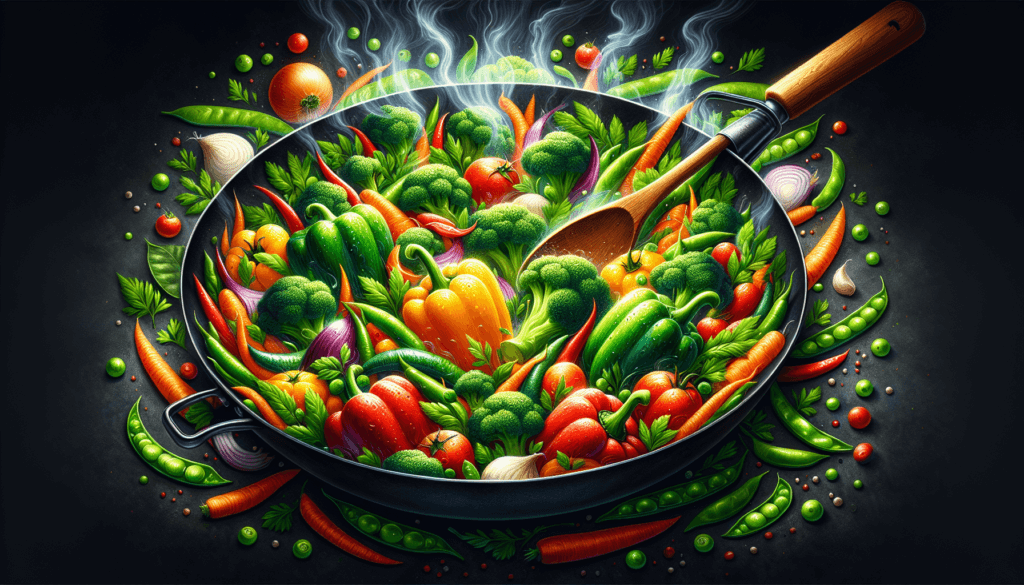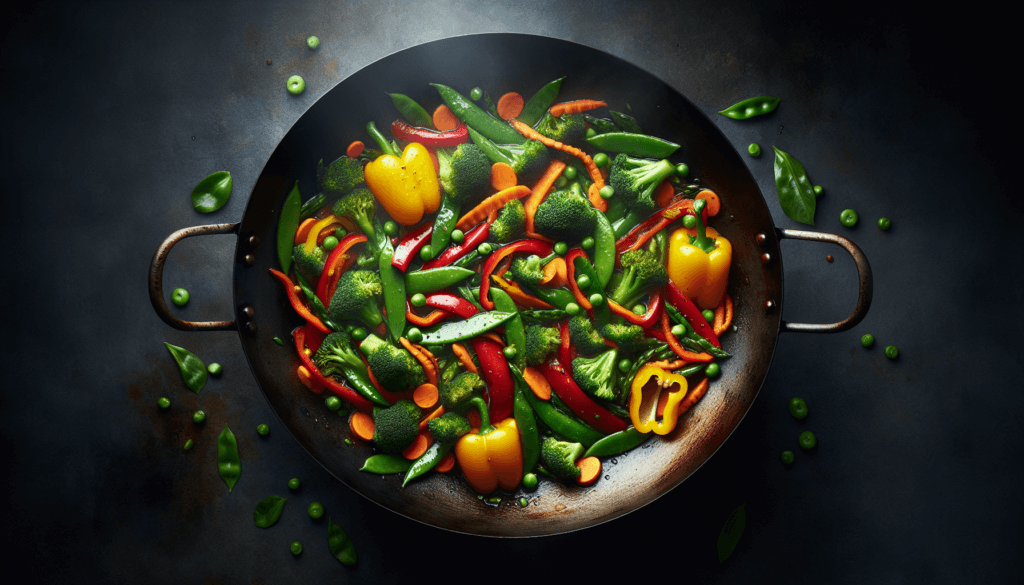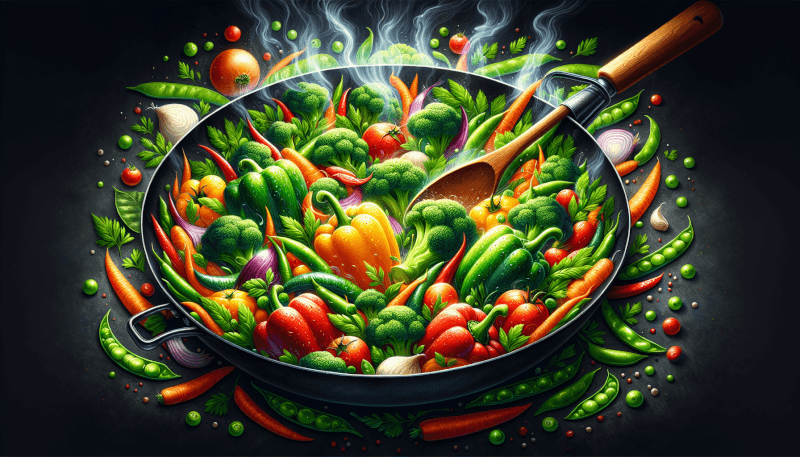Are you tired of your stir-fry dishes turning into a mushy mess? Look no further! In this article, we will share with you 10 essential cooking tips that will help you create the best stir-fry ever. From selecting the right vegetables to mastering the art of seasoning, these tips will take your stir-fry game to the next level. So, grab your wok and get ready to create delicious, flavorful stir-fry dishes that will wow your friends and family!

Choosing the Right Ingredients
Use fresh vegetables
When making a stir-fry, it’s important to start with fresh vegetables. Look for vibrant colors and firm textures when selecting your veggies. Fresh vegetables will not only add a burst of flavor to your stir-fry, but they will also retain their crispness and nutrients. Consider using a variety of vegetables for a colorful and nutritious stir-fry.
Select the right protein
The choice of protein in your stir-fry can greatly impact the overall taste and texture. Whether you prefer chicken, beef, pork, shrimp, or tofu, make sure to select high-quality, fresh ingredients. Opt for lean cuts of meat and firm tofu to ensure they hold up well during the cooking process. Marinating the protein beforehand can also enhance its flavor and tenderness.
Choose the right type of noodles
Noodles are an essential component of a stir-fry dish, and choosing the right type can make all the difference. Consider using rice noodles, wheat noodles, or even egg noodles depending on your preference. Each type of noodle has a distinct texture and flavor, so experiment to find your favorite. Be sure to follow the cooking instructions on the package to achieve perfectly cooked noodles.
Have all the ingredients ready before you start cooking
Preparation is key when it comes to stir-frying. Before you start cooking, make sure to have all your ingredients washed, chopped, and ready to go. Stir-fries come together quickly, so having everything prepared beforehand will ensure a smooth cooking process. Additionally, having your sauces and seasonings measured and readily accessible will help you stay organized and prevent any last-minute scrambling.
Preparation and Cutting Techniques
Preheat your wok or pan
Before you begin stir-frying, it’s essential to preheat your cooking vessel. Whether you’re using a wok or a pan, heating it up beforehand will ensure that your ingredients cook quickly and evenly. Heat the wok or pan on high heat until it starts to smoke slightly. This will create the perfect environment for a stir-fry, allowing the ingredients to retain their crunch and vibrant colors.
Cut ingredients into uniform sizes
To ensure even cooking, it’s important to cut your ingredients into uniform sizes. This will help maintain a consistent texture and prevent some pieces from being overcooked while others remain undercooked. For example, slice your vegetables into similar-sized pieces and cut your protein into bite-sized chunks. This will ensure that all the elements of your stir-fry are cooked to perfection.
Marinate the protein beforehand
To enhance the flavor and tenderness of your protein, consider marinating it before adding it to the stir-fry. A simple marinade of soy sauce, garlic, ginger, and a touch of sugar can work wonders. Allow the protein to marinate for at least 30 minutes, or even overnight, to infuse it with delicious flavors. Just be sure to drain off any excess marinade before stir-frying.
Prepare a flavorful stir-fry sauce
A well-balanced stir-fry sauce is the key to a delicious stir-fry dish. Combine ingredients like soy sauce, oyster sauce, rice vinegar, and a sweetener like honey or brown sugar to create a flavorful base. You can also add other seasonings like chili paste, garlic, or ginger to add complexity to your sauce. Adjust the ratios of the ingredients to suit your taste preferences.

Cooking Techniques
Stir-fry in small batches
One of the secrets to a successful stir-fry is to cook in small batches. Overcrowding the pan with too many ingredients at once can cause them to steam instead of stir-fry, resulting in a soggy dish. By stir-frying in smaller batches, you can maintain high heat throughout the cooking process, ensuring that each ingredient gets the perfect amount of heat and retains its texture.
Cook over high heat
Stir-fries are meant to be cooked quickly over high heat. This technique helps to seal in the flavors and maintain the vibrant colors of the ingredients. High heat also allows for quick cooking, ensuring that the vegetables retain their crispness and the protein stays tender. Be sure to stay attentive while stir-frying on high heat, as the ingredients can cook rapidly.
Maintain the texture of the vegetables
In a good stir-fry, the vegetables should maintain their crispness and vibrant colors. To achieve this, be mindful of the cooking time for each vegetable. Start by stir-frying the ones that require more time, such as carrots or broccoli, and gradually add the ones that cook quickly, such as snow peas or bell peppers. This way, you can ensure that each vegetable retains its desired texture.
Avoid overcrowding the pan
As mentioned earlier, overcrowding the pan is one of the biggest mistakes you can make when stir-frying. It prevents the ingredients from coming into direct contact with the high heat and can lead to steaming instead of stir-frying. By stir-frying in smaller batches and leaving enough space between the ingredients, you can achieve the desired texture and flavor in your stir-fry.
Flavoring and Seasoning
Make use of aromatics
Aromatics like garlic, ginger, and scallions are a staple in stir-fry cooking. They add a depth of flavor and fragrance to your dishes. Begin by sautéing minced garlic and ginger in hot oil before adding other ingredients to release their aromas. You can also add thinly sliced scallions towards the end of cooking for a burst of freshness. Aromatics enhance the overall flavor profile of your stir-fry.
Experiment with different sauces
Don’t be afraid to get creative with your stir-fry sauces. While traditional sauces like soy sauce and oyster sauce work wonders, feel free to experiment with other options. Consider adding hoisin sauce, teriyaki sauce, or even a spicy chili sauce to create unique flavor profiles. Just be mindful of the balance of flavors and taste as you go, adjusting the amount of sauce to suit your preference.
Balance the flavors with salt, sugar, and acidity
The key to a perfectly seasoned stir-fry is achieving a balance of flavors. Salt, sugar, and acidity play crucial roles in achieving this balance. Taste your stir-fry as you go and adjust the seasoning accordingly. Add a pinch of salt, a sprinkle of sugar, or a squeeze of lime or lemon juice to brighten up the flavors. The right balance will elevate your stir-fry to the next level.
Add garnishes for a finishing touch
Garnishing your stir-fry not only adds visual appeal but also enhances the overall flavor. Fresh herbs like cilantro or Thai basil can provide a burst of freshness. Adding a sprinkle of toasted sesame seeds or chopped peanuts can introduce a delightful crunch. Don’t forget a squeeze of fresh lime or lemon juice for a tangy finish. Garnishes are the final touch that completes your stir-fry masterpiece.

Master the Stir-Frying Sequence
Start with the protein
When stir-frying, it’s best to start with cooking the protein. Heat your wok or pan with some oil until it’s hot, then add the protein and cook it until it’s almost cooked through. This ensures that the protein gets enough heat to develop a flavorful crust, while still allowing it to finish cooking with the vegetables and noodles.
Stir-fry the vegetables
Once your protein is nearly cooked, it’s time to add the vegetables. Start with the ones that require more cooking time, such as hard root vegetables or thicker greens. Stir-fry them briefly before adding the remaining vegetables. This gradual addition allows each vegetable to cook just enough without overcooking or becoming soggy.
Mix in the cooked noodles
After stir-frying the vegetables, it’s time to add the cooked noodles to the wok or pan. Use tongs or chopsticks to gently mix the noodles with the vegetables, ensuring they are evenly distributed. This step allows the noodles to soak up the flavors of the stir-fry and become well-coated with the sauce.
Add the stir-fry sauce last
Once the noodles are mixed in, it’s time to add the stir-fry sauce. Pour the sauce over the noodles and vegetables, and toss everything together to ensure each ingredient is well-coated. Adding the sauce last prevents it from becoming excessively absorbed by the noodles or vegetables during the cooking process.
Understanding Heat Control
Get the wok or pan smoking hot
To achieve the perfect stir-fry, it’s crucial to get your wok or pan smoking hot before adding any ingredients. This ensures that the food cooks quickly and maintains its texture and flavors. Heat the wok or pan over high heat until it lightly smokes and then add the oil. This initial blast of heat is essential for a successful stir-fry.
Use the right amount of oil
While stir-frying, it’s important to use the right amount of oil to keep the ingredients from sticking. However, adding too much oil can result in a greasy stir-fry. A tablespoon or two of oil is generally sufficient, but you can adjust the amount based on the number of ingredients and your personal preference. Remember to tilt the wok or pan to evenly distribute the oil before adding the ingredients.
Adjust the heat as you go
Managing heat throughout the stir-frying process is crucial to achieving the desired results. While it’s important to start with high heat to sear the ingredients, you may need to reduce the heat slightly as you add more delicate ingredients. This prevents the food from burning or becoming overly charred. Pay attention to the cooking process and adjust the heat accordingly for each step.
Don’t overcook the ingredients
The art of stir-frying lies in cooking the ingredients quickly while still preserving their textures and flavors. Overcooking can lead to mushy vegetables and tough, dry protein. Keep an eye on the ingredients as you stir-fry and remove them from the heat as soon as they reach the desired doneness. Remember that residual heat will continue to cook the food even after it’s removed from the pan.

Adding Textural Contrasts
Introduce crispy elements
Creating textural contrasts in a stir-fry adds depth and interest to the dish. Introduce crispy elements like water chestnuts, bean sprouts, or thinly sliced bell peppers to give your stir-fry a delightful crunch. These ingredients retain their texture even after stir-frying and provide a pleasant contrast to the softness of the noodles and protein.
Include soft and tender components
In addition to crispy elements, it’s important to have soft and tender components in your stir-fry. This can include vegetables like mushrooms, baby corn, or bok choy, which add a melt-in-your-mouth texture. Softening these ingredients slightly during the stir-frying process enhances their flavors and ensures a satisfying balance of textures.
Incorporate crunchy toppings
To elevate the texture of your stir-fry, consider adding crunchy toppings as a finishing touch. Toasted sesame seeds, crushed peanuts, or even crispy fried onions can provide a delightful contrast to the softness of the stir-fry. Sprinkle these toppings over the dish just before serving to add a satisfying crunch that complements the other textures.
Vary the cooking times for different textures
Not all ingredients in a stir-fry require the same cooking time. By varying the cooking times, you can achieve a variety of textures within the dish. For example, stir-fry carrots or broccoli for a shorter amount of time to retain their crispness, while cooking leafy greens or mushrooms more thoroughly for a softer texture. Experiment with different cooking times to find a balance that suits your preferences.
Creating Stir-Fry Variations
Explore different vegetable combinations
One of the joys of stir-frying is the endless variety of vegetable combinations you can experiment with. Mix and match your favorite vegetables to create unique and flavorful stir-fry dishes. Consider combining colorful bell peppers, crunchy snow peas, and tender asparagus for a vibrant vegetable medley. Don’t be afraid to get creative and try new combinations to keep your stir-fries exciting and delicious.
Try different protein options
While chicken, beef, and shrimp are popular protein choices for stir-fries, don’t limit yourself to just these options. Consider incorporating other proteins like thinly-sliced pork, firm tofu, or even seitan for a vegetarian or vegan option. Each protein brings its own unique flavor and texture to the stir-fry, allowing you to create a variety of delicious and satisfying meals.
Experiment with unique seasonings and spices
To add excitement to your stir-fry, venture beyond the traditional stir-fry sauces and experiment with unique seasonings and spices. Consider adding spices like five-spice powder, curry powder, or smoked paprika to infuse your stir-fry with bold flavors. Don’t be afraid to step out of your comfort zone and explore different flavor profiles to create a stir-fry that’s truly one-of-a-kind.
Incorporate international flavors
Embrace the global nature of stir-fry cooking by incorporating international flavors into your dishes. Take inspiration from Thai cuisine by adding flavors like lemongrass, Thai basil, and fish sauce to create a vibrant and fragrant stir-fry. Or experiment with Indian spices like cumin, coriander, and turmeric for a flavorful twist. The possibilities are endless when it comes to infusing your stir-fries with international flair.

Tips for Perfectly Cooked Noodles
Use the right type of noodles
The type of noodles you choose for your stir-fry can greatly impact the final dish. Rice noodles, such as vermicelli or pad Thai noodles, are popular choices that cook quickly and have a delicate texture. Wheat noodles, such as lo mein or udon noodles, provide a heartier texture and can stand up to robust flavors. Choose the noodle type that suits your preferences and complements the other ingredients in your stir-fry.
Do not overcook the noodles
Overcooking noodles can result in a mushy and clumpy stir-fry. Follow the cooking instructions on the noodle package and aim for a slightly al dente texture. Keep in mind that the noodles will continue to cook slightly when added to the stir-fry, so slightly undercooking them beforehand will prevent them from becoming too soft during the cooking process.
Rinse and drain the noodles properly
Properly rinsing and draining the cooked noodles is essential to remove any excess starch and prevent them from sticking together. After cooking the noodles, rinse them under cold water to stop the cooking process and remove any residual starch. Give them a good shake to remove excess water and allow them to drain fully before adding them to the stir-fry.
Toss the noodles with oil to prevent sticking
Just before adding the noodles to the stir-fry, toss them with a small amount of oil. This helps to prevent the noodles from sticking together and ensures they maintain their individual strands. Use a neutral oil like vegetable or canola oil and gently toss the noodles until they are evenly coated. This simple step can make a big difference in the overall texture of your stir-fry.
Utilizing Leftovers in Stir-Fry
Transform leftover proteins into stir-fry ingredients
Stir-fries are a great way to repurpose leftovers, especially leftover proteins. Cooked chicken, beef, pork, or shrimp can be easily incorporated into a stir-fry to create a new and flavorful dish. Simply slice or shred the leftover protein and add it to the stir-fry during the cooking process. The stir-fry will help to reheat the protein and infuse it with new flavors.
Repurpose cooked vegetables in a new stir-fry
Leftover cooked vegetables from a previous meal can also be repurposed in a new stir-fry. Whether it’s roasted vegetables, steamed broccoli, or grilled zucchini, stir-frying them with fresh ingredients and seasonings can give them a new lease on life. Add the cooked vegetables towards the end of the cooking process to warm them through without overcooking.
Make a flavorful sauce using pantry staples
If you find yourself with a limited selection of ingredients, fear not! You can still create a delicious stir-fry by utilizing pantry staples to make a flavorful sauce. Combine soy sauce, garlic, ginger, honey, and cornstarch to create a basic stir-fry sauce. Adjust the ratios to suit your taste preferences and use it to coat the protein and vegetables in your stir-fry.
Using stir-fry as a versatile clean-out-the-fridge meal
Stir-fries are incredibly versatile and make for the perfect clean-out-the-fridge meal. Take inventory of any leftover vegetables, proteins, or cooked grains you have and use them as the base for your stir-fry. The beauty of stir-frying is that you can mix and match ingredients based on what you have on hand, creating a unique meal every time. Enjoy the process of using up ingredients and turning them into a delicious stir-fry creation.
In conclusion, mastering the art of stir-frying involves several key factors, from choosing the right ingredients to understanding cooking techniques and flavor balance. By following these tips and techniques, you can create the best stir-fry dishes that are bursting with flavor, texture, and color. So, gather your fresh ingredients, prepare your wok or pan, and get ready to embark on a culinary adventure in stir-frying!


